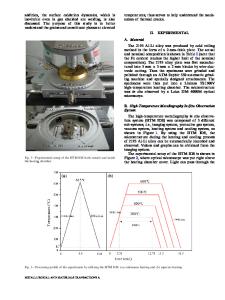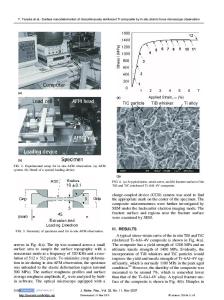In situ high-resolution electron microscope observation of phase change in nanometer-sized alloy particles
- PDF / 4,382,262 Bytes
- 14 Pages / 612 x 792 pts (letter) Page_size
- 86 Downloads / 351 Views
Hidehiro Yasuda Department of Mechanical Engineering, Kobe University, Nada, Kobe 657-8501, Japan (Received 14 December 2004; accepted 2 March 2005)
From the study of alloy phase formation in nanometer-sized particles by in situ transmission electron microscopy, it is revealed that not only the surface energy but also the interface energy of an interface between two different phases (solid–solid or solid–liquid) significantly changes the phase equilibrium of nanometer-sized particles. These energies result in large suppression of the eutectic point, structural instability, and unique solid/liquid two-phase structures in isolated nanometer-sized alloy particles. A theoretical study based on thermodynamics, which is modified in such a manner that Gibbs free energies for bulk materials were modified by taking factors affecting the phase equilibrium of nanometer-sized alloy particles into consideration, was proved useful to evaluate the results obtained from experiments. I. INTRODUCTION
It is now well established that nanometer-sized particles (or their aggregation) exhibit electronic, magnetic, optical, and thermal properties which are significantly different from those of the corresponding bulk materials.1,2 These nanometer-sized particles consist of 103–105 atoms, and the surface-to-volume ratio becomes remarkably large with decreasing particle size. Surface atoms have some broken bonds and are therefore in a high-energy state compared with interior atoms. It is then expected that surface atoms make a large contribution to the unique properties exhibited in nanometer-sized particles. This is called the “surface effect.” To develop a fundamental understanding of this effect, much work has been carried out. For example, in silicon with covalent bonds, the nature of the surface reconstruction was revealed by Takayanagi et al.,3 and it was shown that the surface effect is confined within a very thin surface region. In ionic nanocrystals, Perebeinos et al. reported that competition between the long-range Coulombic attractive and the short-range repulsive interaction induces an effective negative pressure, which causes the lattice parameter to increase with decreasing size of particles.4 Furthermore, in extremely small-sized particles the crystal structure itself can also be modified.5,6 It is also well established that such phase transition temperatures as a
a)
Address all correspondence to this author. e-mail: [email protected] DOI: 10.1557/JMR.2005.0223 1708
http://journals.cambridge.org
J. Mater. Res., Vol. 20, No. 7, Jul 2005 Downloaded: 12 Jan 2015
melting point are significantly reduced with decreasing particle size.7–9 However, all these examples are in relation with nanometer-sized pure substances. To the authors’ knowledge, studies on nanometer-sized alloy particles are quite limited because it was previously rather difficult to control and measure such parameters as temperature (T), size (d), and composition (C) at the same time in a single, isolated nanometer-sized alloy particle. On the other
Data Loading...










